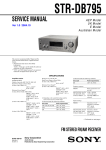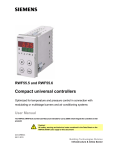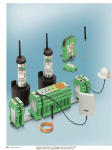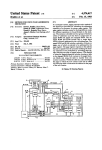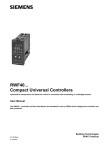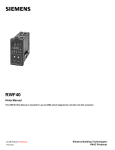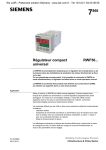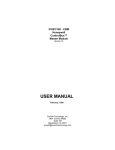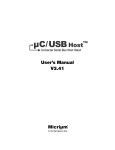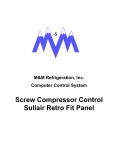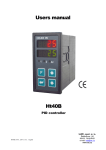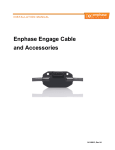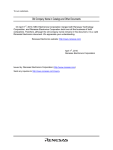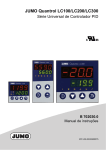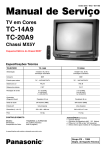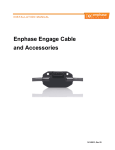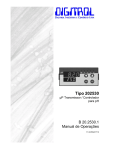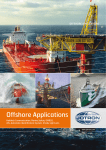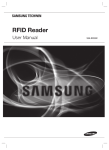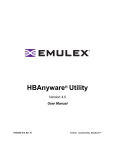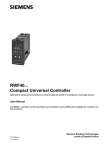Download RWF50.2 and RWF50.3 Compact universal controllers User Manual
Transcript
RWF50.2 and RWF50.3 Compact universal controllers Optimized for temperature and pressure control in connection with modulating or multistage burners and air conditioning systems User Manual The RWF50.2/RWF50.3 and this User Manual are intended for use by OEMs which integrate the controllers in their products! Caution! All safety, warning and technical notes contained in the Data Sheet on the RWF50… (N7866) also apply to this document! CC1U7866en 25.07.2014 Building Technologies Division Infrastructure & Cities Sector 2/64 Building Technologies Division Infrastructure & Cities Sector User Manual RWF50... CC1U7866en 25.07.2014 Supplementary documentation Data Sheet RWF50... ............................................................................................. N7866 Environmental Declaration RWF50... ......................................................................E7866 3/64 Building Technologies Division Infrastructure & Cities Sector User Manual RWF50... Introduction CC1U7866en 25.07.2014 4/64 Building Technologies Division Infrastructure & Cities Sector User Manual RWF50... CC1U7866en 25.07.2014 Contents 1 Introduction ...................................................................................................... 8 1.1 General notes .................................................................................................. 8 1.2 Typographical conventions .............................................................................. 9 1.2.1 Safety notes..................................................................................................... 9 1.2.2 Warning symbols ............................................................................................. 9 1.2.3 Notification symbols....................................................................................... 10 1.2.4 Presentation .................................................................................................. 10 1.3 Description..................................................................................................... 11 1.4 Block structure ............................................................................................... 12 2 Identification of product no. ........................................................................... 13 2.1 Type field ....................................................................................................... 13 2.2 Scope of delivery ........................................................................................... 13 3 Installation ..................................................................................................... 14 3.1 Installation site and climatic conditions.......................................................... 14 3.2 Dimensions .................................................................................................... 14 3.3 Side-by-side mounting ................................................................................... 15 3.4 Mounting the controller in a panel cutout....................................................... 15 3.5 Removing the controller from the panel cutout .............................................. 16 3.6 Cleaning the front .......................................................................................... 16 4 Electrical connections .................................................................................... 17 4.1 Installation notes............................................................................................ 17 4.2 Galvanic separation ....................................................................................... 18 4.3 Assignment of terminals ................................................................................ 19 5 Operating modes ........................................................................................... 21 5.1 Low-fire operation .......................................................................................... 21 5.2 High-fire operation ......................................................................................... 22 5.2.1 Modulating burner, 3-position output ............................................................. 22 5.2.2 Modulating burner, analog output .................................................................. 23 5.2.3 2-stage burner, 3-position output................................................................... 24 5.2.4 2-stage burner, analog output ....................................................................... 25 5.3 Burner shutdown ........................................................................................... 26 5.4 Predefined setpoint........................................................................................ 27 5.5 Response threshold (q) ................................................................................. 28 5.6 Cold start of plant .......................................................................................... 29 5.7 Thermal shock protection (TSS) .................................................................... 31 6 Operation ....................................................................................................... 32 5/64 Building Technologies Division Infrastructure & Cities Sector User Manual RWF50... Contents CC1U7866en 25.07.2014 6.1 Meaning of display and buttons .....................................................................32 6.2 Basic display ..................................................................................................33 6.3 User level .......................................................................................................34 6.4 Manual control, modulating burner ................................................................35 6.5 Manual control, 2-stage burner ......................................................................36 6.6 Starting the self-setting function.....................................................................37 6.7 Display of software version ............................................................................38 7 Parameterization PArA ....................................................................................39 8 Configuration ConF ..........................................................................................41 8.1 Analog input InP1 ...........................................................................................42 8.2 Controller Cntr ................................................................................................43 8.3 Thermal shock protection (TSS) rAFC ............................................................44 8.4 Control outputs OutP.......................................................................................45 8.5 Binary input binF ............................................................................................46 8.6 Display diSP ...................................................................................................47 9 Self-setting function .......................................................................................48 9.1 Self-setting function in high-fire operation......................................................48 9.2 Checking the controller parameters ...............................................................50 10 PC software ACS411 .....................................................................................51 10.1 Safety notes ...................................................................................................51 10.2 Setting the correct system parameters ..........................................................51 10.3 Changing the parameters ..............................................................................51 10.4 Place of installation ........................................................................................52 10.5 License and liability regulations .....................................................................52 10.6 Procurement of PC software ACS411 ...........................................................52 10.7 Languages .....................................................................................................52 10.8 Operating systems : Operating ......................................................................52 10.9 Prerequisites for hardware .............................................................................52 10.10 Installation ......................................................................................................53 10.11 Others ............................................................................................................53 10.11.1 Use of USB port : Use of................................................................................53 10.11.2 Powering the controller via the USB port : Powering the controller via the port .................................................................................................................53 11 What to do if ... ...............................................................................................54 11.1 Alarm messages: ...........................................................................................54 11.2 Others ............................................................................................................54 12 Technical data................................................................................................55 12.1 Inputs .............................................................................................................55 6/64 Building Technologies Division Infrastructure & Cities Sector User Manual RWF50... Contents CC1U7866en 25.07.2014 12.1.1 Resistance thermometers.............................................................................. 55 12.1.2 Input signals .................................................................................................. 55 12.1.3 Binary input D1 .............................................................................................. 55 12.2 Monitoring the measuring circuit.................................................................... 56 12.3 Controller outputs OutP Controller o.............................................................. 56 12.4 Controller ....................................................................................................... 56 12.5 Electrical data ................................................................................................ 57 12.6 Housing ......................................................................................................... 57 12.7 Environmental conditions .............................................................................. 58 12.8 Segment display ............................................................................................ 58 12.9 Standards and certificates ............................................................................. 58 13 Key ................................................................................................................ 59 14 List of figures ................................................................................................. 61 7/64 Building Technologies Division Infrastructure & Cities Sector User Manual RWF50... Contents CC1U7866en 25.07.2014 1 Introduction 1.1 General notes Please read this User Manual before switching on the controller. Keep the User Manual in a safe place which can be accessed by all users at all times. Version! This User Manual describes all necessary settings (applicable to controller software version XXX.01.01). Reference! See chapter 6.7 Display of software version. Should any problems arise during commissioning, do not make any unauthorized manipulations on the unit. You could endanger your rights under the warranty terms! Please contact us in such a case. 8/64 Building Technologies Division Infrastructure & Cities Sector User Manual RWF50... 1 Introduction CC1U7866en 25.07.2014 1.2 Typographical conventions 1.2.1 Safety notes This User Manual contains information which must be observed to ensure your own personal safety and to prevent damage to equipment and property. The instructions and notes are highlighted by warning triangles, a hand or arrow symbol and are presented as follows, depending on the hazard level: Qualified personnel Only qualified personnel are allowed to install and operate the equipment. Qualified personnel in the context of the safety-related notes contained in this document are persons who are authorized to commission, ground and tag devices, systems and electrical circuits in compliance with established safety practices and standards. Correct use Note the following: The controller may only be used on the applications described in the technical documentation and only in connection with devices or components from other suppliers that have been approved or recommended by Siemens. The product can only function correctly and safely if shipped, stored, set up and installed correctly, and operated and maintained as specified. 1.2.2 Warning symbols The symbols for Caution and Attention are used in this User Manual under the following conditions: Caution This symbol is used where there may be a danger to personnel if the instructions are disregarded or not strictly observed! Attention This symbol is used where damage to equipment or data can occur if the instructions are disregarded or not strictly observed! Attention This symbol is used if precautionary measures must be taken when handling electrostatically sensitive components. 9/64 Building Technologies Division Infrastructure & Cities Sector User Manual RWF50... 1 Introduction CC1U7866en 25.07.2014 1.2.3 Notification symbols Note This symbol is used to draw your special attention to a remark. Reference This symbol refers to additional information in other documents, chapters or sections. abc¹ Footnote Footnotes are comments, referring to specific parts of the text. They consist of 2 parts: 1) Markings in the text are arranged as continuous superscript numbers 2) Footnote text is placed at the bottom of the page and starts with a number and a period * Action An asterisk indicates that a required action is described. The individual steps are indicated by asterisks, for example: * Press 1.2.4 Presentation Buttons ESC Enter + Buttons are shown in a circle. Either symbols or text are possible. If a button has multiple assignments, the text shown is always the text corresponding to the function currently used. Button Two buttons shown in combination with a plus sign combinations means that they must be pressed simultaneously. ConF InP Command chain InP1 Arrows between words serve for finding parameters at the configuration level more easily or for navigating in the ACS411 setup program. 10/64 Building Technologies Division Infrastructure & Cities Sector User Manual RWF50... 1 Introduction CC1U7866en 25.07.2014 1.3 Description Use in heating plants The RWF50... is used primarily for the control of temperature or pressure in oil- or gasfired heating plants. Depending on the model, it is employed as a compact 3-position controller without feedback of angular positioning or as a modulating controller with an analog output. An external switch is provided to convert it to a 2-position controller for controlling 2-stage burners. The built-in thermostat function switches the burner on and off. Cooling controller The controller’s operating mode can be changed from heating to cooling, or vice versa. Reference! See chapter 8.2 Controller Cntr. RWF50... The controllers feature two 4-digit 7-segment displays for the actual value (red) and the setpoint (green). The RWF50.2 has a 3-position output consisting of 2 relays to open or close a controlling element. The RWF50.3 has an analog output. Control In modulating mode, the RWF50... operates as a PID controller. In 2-stage mode, the RWF50... provides control based on the set switching threshold. Using the binary input, a change to a second setpoint can be made or the setpoint can be shifted. Standard feature is a self-setting function used to determine the PID control parameters. Mounting The controller insert measures 48 x 48 x 104 mm and is especially suited for installation in control panels. All electrical connections are made via screw terminals at the rear of the unit. 11/64 Building Technologies Division Infrastructure & Cities Sector User Manual RWF50... 1 Introduction CC1U7866en 25.07.2014 1.4 Block structure Only RWF50.2: Air damper control Only RWF50.3: Figure 1: Block structure 12/64 Building Technologies Division Infrastructure & Cities Sector User Manual RWF50... 1 Introduction CC1U7866en 25.07.2014 2 Identification of product no. 2.1 Type field The type field is glued onto the housing. The arrow below indicates the product no. Location: Example Product nos. : Attention! Mains supply must correspond to the operating voltage given on the type field. Product no. RWF50.20A9 RWF50.21A9 RWF50.30A9 RWF50.31A9 Description Basic version with 3-position output – single pack Basic version with 3-position output – multipack Basic version with analog output – single pack Basic version with analog output – multipack 2.2 Scope of delivery - Type of controller as ordered - User Manual 13/64 Building Technologies Division Infrastructure & Cities Sector User Manual RWF50... 2 Identification of product no. CC1U7866en 25.07.2014 3 Installation 3.1 Installation site and climatic conditions - The installation site should be free from vibrations, dust and corrosive media - The controller should be installed away from sources of electromagnetic fields, such as variable speed drives or high-voltage ignition transformers Relative humidity: 95% (noncondensing) Ambient temperature: -20...50 °C Storage temperature: -40...70 °C 50 3.2 Dimensions 104 7866m01/0714 Figure 2: Dimensions of RWF50... Key (1) USB interface setup (2) Panel cutout 14/64 Building Technologies Division Infrastructure & Cities Sector User Manual RWF50... 3 Installation CC1U7866en 25.07.2014 3.3 Side-by-side mounting If several controllers are mounted side-by-side or above one another in a control panel, the horizontal distance between panel cutouts must be a minimum of 11 mm and the vertical distance a minimum of 50 mm. 3.4 Mounting the controller in a panel cutout * * Remove the frame Fit the seal supplied with the controller Attention! The controller must be installed with the seal, preventing water or dirt from entering the housing! (2) 7866z02/0714 (1) Figure 3: Mounting in a panel cutout * * Insert the controller from the front into the panel cutout (1) and make certain the seal is correctly fitted Fit the frame from the rear (2) and let it engage in the grooves 15/64 Building Technologies Division Infrastructure & Cities Sector User Manual RWF50... 3 Installation CC1U7866en 25.07.2014 3.5 Removing the controller from the panel cutout Attention! When removing the controller, make certain that all cables are disconnected and that they do not get squeezed between control panel and housing. 3.6 Cleaning the front The front of the controller can be cleaned with normal washing/rinsing agents or detergents. Attention! The front of the controller is not resistant to corrosive acids, caustic solutions and abrasive cleaners. Do not clean with high-pressure cleaners! 16/64 Building Technologies Division Infrastructure & Cities Sector User Manual RWF50... 3 Installation CC1U7866en 25.07.2014 4 Electrical connections 4.1 Installation notes Safety regulations - The choice of cable, installation and electrical connections of the controller must conform to VDE 0100 Regulations for the installation of power circuits with nominal voltages below AC 1000 V, or the relevant local regulations - The electrical connections must be made by qualified personnel - If contact with live parts is possible while working on the unit, the controller must be disconnected from power supply (all-polar disconnection) Connection of external components Caution! Screw terminals Caution! All screw terminals at the rear of the unit must always be properly tightened. This applies to unused terminals as well. Fusing Caution! - Fusing on site must not exceed 20 A When connecting external components to the safety extra low-voltage inputs or outputs of the RWF50... (terminals 11, 12, 13, D1, DG, G+, G-, A+, A-, and USB port), it must be made certain that no dangerous active voltage are introduced to the RWF50... This can be achieved by using capsulated components with double/reinforced insulation or SELV components, for example. If not observed, there is a risk of electric shock. - The fuse on the controller side (AC 250 V/1.6 A slow) conforms to IEC 60127-4 - To prevent the relay contacts from welding in the event of short-circuit in the load circuit, fusing of the output relays must give consideration to the maximum permissible relay current Reference! See chapter 12.3 Controller outputs OutP. - No other loads may be connected to the controller’s main power supply terminals Suppression of interference - The electromagnetic compatibility and interference suppression levels conform to the standards and regulations listed under Technical data Reference! See chapter 12.5 Electrical data. - Input, output and supply cables should be routed separately, not parallel to one another - All input and output lines without connection to the power supply network must be shielded and twisted. They must not be run close to live components or live cables. On the controller side. Incorrect use - The controller is not suited for installation in areas with explosion hazard - Incorrect settings on the controller (setpoint, data of parameter and configuration levels) can affect proper functioning of the process or lead to damage. Safety devices independent of the controller, such as overpressure relief valves or temperature limiters/monitors should therefore always be provided, and only be capable of adjustment by qualified personnel. Please observe the relevant safety regulations. Since self-setting cannot be expected to handle all possible control loops, the stability of the resulting actual value should be checked 17/64 Building Technologies Division Infrastructure & Cities Sector User Manual RWF50... 4 Electrical connections CC1U7866en 25.07.2014 4.2 Galvanic separation The illustration shows the maximum test voltages between the electrical circuits. Analog input InP For resistor thermometer or standard signals Binary input D1 For potential-free contacts USB interface Setup For PC software ACS411 LED Buttons Burner release 1P, 1N Relay (NO contact) Power supply measuring transducer G+, GDC 24 V +10%/max. 25 mA (short-circuit-proof) Power consumption Max. 16 VA at AC 110...240 V, +10%/-15%, 48...63 Hz Only RWF50.3 Analog output A+, A7866d02e/1212 DC 50 V AC 1500 V AC 3300 V Figure 4: Test voltages 18/64 Building Technologies Division Infrastructure & Cities Sector User Manual RWF50... 4 Electrical connections CC1U7866en 25.07.2014 4.3 Assignment of terminals Caution! Electrical connections must always be made by qualified personnel! 7866z09/0911 Figure 5: Assignment of terminals Outputs Display LED Terminal no. 1P pole Connection diagram 1P P Relay Burner release: Relay K1: P, 1N S 1N NO contact K3 NO contact KQ common pole 1N K3 S Only RWF50.2 3-position output: 7866a01/0911 P KQ Relay K3: Controlling element CLOSE P Relay K2: Controlling element OPEN K2 NO contact S K2 7866a02/0911 Only RWF50.3 A+ A+ Analog output A+, ADC 0(4)...20 mA, DC 0...10 V A- A- + - 7866a03/0911 19/64 Building Technologies Division Infrastructure & Cities Sector User Manual RWF50... 4 Electrical connections CC1U7866en 25.07.2014 Analog input InP1 Terminal no. Connection diagram 11 Resistance thermometer in 3-wire circuit 12 13 11 13 + Resistance thermometer in 2-wire circuit 12 Current input DC 0...20 mA, 4...20 mA 12 Ix 13 7866a06/0911 + 11 Voltage input DC 0...5 V, 1...5 V, 0...10 V 13 11 Ux 13 Binary inputs binF 7866a06/0911 Terminal no. 13 Connection diagram D1 D1 Binary input D1 Common ground DG DG Power supply 7866a08/0911 Terminal no. L1 Live conductor Power supply AC 110...240 V +10%/-15%, 48...63 Hz N G+ Power supply measuring transducer (short-circuit-proof) G- Neutral conductor DG Connection diagram L1 N 7866a09/0911 G+ + DC 24 V +10% max. 25 mA G7866a10/0412 20/64 Building Technologies Division Infrastructure & Cities Sector User Manual RWF50... 4 Electrical connections CC1U7866en 25.07.2014 5 Operating modes 5.1 Low-fire operation Low-fire operation means that only small amounts of heat are drawn from the boiler. Using relay K1 Burner release, the 2-position controller ensures control to the setpoint by switching the burner on and off like a thermostat. Thermostat function This mode of control is known as the thermostat function. An adjustable switching differential ensures that the burner’s switching frequency can be selected, aimed at reducing wear. Modulating and 2-stage operation: Actual value lies between switch-on threshold HYS1 and switch-off threshold HYS3. Heating controller ON OFF 7866d03e/1011 Figure 6: Control sequence of heating controller Cooling controller If the controller is set to cooling mode, temperature limits HYS4 and HYS6 apply. In that case, relay K1 Burner release is used for controlling the cooling equipment. Modulating and 2-stage operation: Actual value lies between switch-on threshold HYS4 and switch-off threshold HYS6. ON OFF 7866d04e/1011 Figure 7: Control sequence of cooling controller 21/64 Building Technologies Division Infrastructure & Cities Sector User Manual RWF50... 5 Operating modes CC1U7866en 25.07.2014 5.2 High-fire operation High-fire operation means that large amounts of heat are drawn from the boiler so that the burner runs continuously. If the heating load during low-fire operation rises to a level where the actual value begins to fall below switch-on threshold HYS1 , the controller will not immediately switch to a higher burner output, but first makes a dynamic test of the control deviation and switches to the higher output only when an adjustable threshold (q) is exceeded (A). Reference! See chapter 5.5 Response threshold (q). - In high-fire operation – depending on the application – the burner can be fired in modulating or 2-stage operation, then burning larger amounts of fuel than in low-fire operation. Binary input D1 can be used to switch between modulating and 2-stage operation - Contacts D1 and DG open: Modulating burner operation - Contacts D1 and DG closed: 2-stage burner operation Operating mode changeover Reference! See chapter 8.5 Binary functions binF. 5.2.1 Modulating burner, 3-position output Only RWF50.2 In area (1), the thermostat function is active. The lowest burner stage is switched on below switch-on threshold HYS1 and switched off above switch-off threshold HYS3. Area (1) 7866d05/0911 Figure 8: Control sequence of modulating burner, 3-position output Area (2) Here, operating mode Modulating burner is shown. In high-fire operation, the 3-position controller acts on an actuator via relay K2 (OPEN) and relay K3 (CLOSE). When the actual value falls below the setpoint, the response threshold (q) at point (A) is reached and the controlling element opens (greater heat output). When the actual value lies within the dead band db, the controlling element remains inactive. When the actual value exceeds db, the controlling element closes (smaller heat output). Area (3) If the actual value exceeds the upper switch-off threshold HYS3 in spite of the lowest heating stage, the controller switches the burner off (B). The controller only starts lowfire operation when the actual value falls below switch-on threshold HYS1 again. If the response threshold (q) is exceeded, the controller switches to high-fire operation (A). Reference! See chapter 5.5 Response threshold (q). 22/64 Building Technologies Division Infrastructure & Cities Sector User Manual RWF50... 5 Operating modes CC1U7866en 25.07.2014 5.2.2 Modulating burner, analog output Only RWF50.3 Area (1) Thermostat function active. Area (2) The RWF50.3 as a modulating controller provides control to the adjusted setpoint. Angular positioning is ensured via the analog output in the form of a standard signal. A 7866d06/0911 Figure 9: Control sequence of modulating burner, analog output Area (3) The controller behaves as described in chapter 5.2.1 Modulating burner, 3-position output. Cooling controller If the controller is set to cooling mode, the respective values HYS4 and HYS6 apply. Starting from a high actual value, the controller now controls the connected cooling equipment in low-fire operation. In high-fire operation, the cooling output is controlled via relays K2 and K3 or the analog output. The response threshold (q) calculates automatically (now in the reverse sense) the point from which the cooling output is to be increased. 23/64 Building Technologies Division Infrastructure & Cities Sector User Manual RWF50... 5 Operating modes CC1U7866en 25.07.2014 5.2.3 2-stage burner, 3-position output In area (1), the thermostat function is active. In area (2), the RWF50.2 as a 2-position controller acts on the second stage via relay K2 (OPEN) and relay K3 (CLOSE) by switching on at switch-on threshold HYS1 and switching off at switch-off threshold HYS2. Only RWF50.2 7866d07/0911 Figure 10: Control sequence of 2-stage burner, 3-position output In area (3), the actual value exceeds the upper switch-off threshold HYS3 and the controller shuts down the burner (B). The controller only starts low-fire operation when the actual value falls again below switch-on threshold HYS1. If the response threshold (q) is exceeded, the controller switches to high-fire operation (A). Reference! See chapter 5.5 Response threshold (q). 24/64 Building Technologies Division Infrastructure & Cities Sector User Manual RWF50... 5 Operating modes CC1U7866en 25.07.2014 5.2.4 2-stage burner, analog output Only RWF50.3 In this case, a digital standard signal switches the second stage on via the analog output (terminals A+ and A-) when reaching switch-on threshold HYS1 and off at the lower switch-off threshold HYS2. A 7866d08/0911 Figure 11: Control sequence of 2-stage burner, analog output Cooling controller If the controller is set to cooling mode, the respective values of HYS4, HYS5 and HYS6 apply. Starting from a high actual value, the controller now controls the connected cooling equipment in low-fire operation. In high-fire operation, the second stage and thus the cooling output are controlled via relays K2 and K3 or the analog output. The response threshold (q) calculates automatically (now in the reverse sense) the point from which the cooling output is to be increased. 25/64 Building Technologies Division Infrastructure & Cities Sector User Manual RWF50... 5 Operating modes CC1U7866en 25.07.2014 5.3 Burner shutdown In the event of a sensor failure at the analog input InP1, the controller cannot monitor the actual value. Burner shutdown will automatically be triggered to guard against overheating. Functions - Burner off - 3-position output for closing the controlling element - Self-setting function is ended - Manual control is ended 26/64 Building Technologies Division Infrastructure & Cities Sector User Manual RWF50... 5 Operating modes CC1U7866en 25.07.2014 5.4 Predefined setpoint The setpoint is predefined within the selected setpoint limits via the buttons or the ACS411 software. Using an external contact, the setpoint can also be shifted or changed over. Setpoint changeover or setpoint shift Reference! See chapter 8.5 Binary functions binF. Depending on the function selected for the binary input, the effective controller setpoint can change between setpoint SP1 and setpoint SP2 or can be shifted by the amount of dSP. A contact at binary input D1 controls the changeover or shift. The values for setpoints SP1, SP2 and dSP are to be entered at the operating level. Entry Reference! See chapter 6 Operation. SP1 dSP SP2 Contact at binary input D1 Open: 0 Closed: 1 D1 D1 DG DG 0 1 0 1 + Chapter 4.3 Assignment of pins Function of binary input D1 None (factory-set) Setpoint changeover Setpoint shift bin1 0 1 2 0 1 2 Chapter 8.5 Binary functions binF SPH/oLHi SPL/oLLo Chapter 8.2 Controller Cntr 7866a11e/0412 Active setpoint Figure 12: Setpoint changeover or setpoint shift 27/64 Building Technologies Division Infrastructure & Cities Sector User Manual RWF50... 5 Operating modes CC1U7866en 25.07.2014 5.5 Response threshold (q) The response threshold (q) defines for what period of time and how much the actual value is allowed to drop before the system switches to high-fire operation. An internal mathematical calculation using an integration function determines the sum of all areas qeff = q1 + q2 + q3 as shown in the graph. This takes place only when the control deviation (x-w) falls below the value of switch-on threshold HYS1. If the actual value increases, integration is stopped. If qeff exceeds the preset response threshold (q) (can be adjusted at the parameter level), this causes the second burner stage to switch on or – in the case of the 3position controller/modulating controller – the controlling element to open. If the current boiler temperature reaches the required setpoint, qeff is reset to 0. Temperature (°C) q q 7866d09e/0412 q q Figure 13: Control sequence response threshold (q) In contrast to time-dependent switching on, load-dependent switching on offers the advantage of capturing the dynamics of the actual value. Also, monitoring the progression of the actual value during the change from low-fire to high-fire ensures low switching frequencies to reduce wear and to extend running times. Cooling controller The response threshold (q) also works (in the reverse sense) in the case of cooling mode. 28/64 Building Technologies Division Infrastructure & Cities Sector User Manual RWF50... 5 Operating modes CC1U7866en 25.07.2014 5.6 Cold start of plant Interlocking Heating controller Note! Functions Cold start of plant and Thermal shock protection (TSS) are interlocked. Only one function can be activated, but never both at the same time. When a heating system is switched off for a longer period of time, the actual value will drop of course. To achieve a faster control response, the controller immediately starts in high-fire operation as soon as the control deviation (x-w) drops below a certain limit value. This limit is calculated as follows: Limit value = 2 x (HYS1-HYS3) In that case, the response threshold (q) is inactive, independent of operating mode and controlled variable (temperature or pressure). Example Operating mode: Modulating, 3-position output HYS1 = -5 K HYS3 = +5 K w = 60 °C Limit value = 2 x (-5-5) = 2 x (-10) = -20 K At an actual value below 40 °C, heating up immediately starts in low-fire operation, and not in thermostat mode. HYS3 db 2x (HYS1-HYS3) HYS1 7866d10(0911 Figure 14: Control sequence Cold start of plant 29/64 Building Technologies Division Infrastructure & Cities Sector User Manual RWF50... 5 Operating modes CC1U7866en 25.07.2014 Cooling controller Cold start of plant also works when the RWF50… is used as a cooling controller. In that case, the limit value is calculated as follows: Limit value = 2 x (HYS4-HYS6) Example Operating mode: Modulating 3-position output HYS4 = 5 K HYS6 = -5 K w = -30 °C Limit value = 2 x (5 +5) = 2 x (10) = +20 K When the actual value lies above -10 °C, cooling is immediately started in high-fire mode in place of low-fire mode. 30/64 Building Technologies Division Infrastructure & Cities Sector User Manual RWF50... 5 Operating modes CC1U7866en 25.07.2014 5.7 Thermal shock protection (TSS) Interlocking Note! Functions Cold start of plant and Thermal shock protection (TSS) are interlocked. Only one function can be activated, but never both at the same time. The controller comes with thermal shock protection (TSS) deactivated; it can be activated at the configuration level. Reference! See chapter 8.3 Thermal shock protection (TSS) rAFC. The function is automatically activated when the actual value drops below the adjustable limit value rAL (exceeds the adjustable limit value with the cooling controller). In that case, the setpoint is approached via a ramp function. Gradient and slope of the ramp rASL are adjustable. The setpoint ramp has a symmetrical tolerance band toLP. If, during the startup phase, the actual value leaves the tolerance band, the setpoint ramp is stopped until the actual value returns to a level within the tolerance band. The startup phase is ended when the setpoint of the ramp function reaches the final setpoint SP1. Function Note! When thermal shock protection (TSS) is active, the controller operates in low-fire operation. The response threshold (q) is active. 7866d20e/0212 Temperature SP1 rAL toLP t1 t2 t3 t4 t Figure 15: Thermal shock protection (TSS) Key Setpoint (w) Actual value (x) 31/64 Building Technologies Division Infrastructure & Cities Sector User Manual RWF50... 5 Operating modes CC1U7866en 25.07.2014 6 Operation 6.1 Meaning of display and buttons Burner release Operating mode 2-stage Actual value display (red) and parameter value USB-LED Controlling element CLOSE Setpoint display (green) and parameter symbol Controlling element OPEN Enter button ESC button Decrease value ESC Enter RWF50.x Increase value 7866z03e/0212 Figure 16: Meaning of display and buttons Initialization The two 7-segment displays (red and green) show hyphens and all LEDs light up for about 5 seconds. Basic display The upper display (red) shows the actual value. The lower display (green) shows the setpoint. Reference! See chapter 8.6 Display diSP. Parameter display When entering parameters, the parameter symbol at the bottom (green) and the set value at the top (red) appear. Self-setting function The actual value is shown on the actual value display (red) and tUnE flashes on the setpoint display (green). Reference! See chapter 9 Self-setting function. The actual value display (red) shows 9999 flashing. Flashing actual value display Reference! See chapter 11 What to do if ... The setpoint display (green) shows HAnd flashing. Manual control Reference! See chapter 6.4 Manual control of a modulating burner. 32/64 Building Technologies Division Infrastructure & Cities Sector User Manual RWF50... 6 Operation CC1U7866en 25.07.2014 6.2 Basic display When switching power on, the displays show hyphens for about 5 seconds. RWF50.X 7866z11/0112 Figure 17: Display start The state that follows is called normal display. Default display is the actual value and the current setpoint. Other values can be displayed at the configuration level or via PC software ACS411. Reference! See chapter 8.6 Display diSP. Manual control, self-setting, the user, parameter and configuration levels can be activated from here. Setpoint SP1 increase (factory-set) Enter Basic display Enter Enter OPr User level OPr Editable: SP1, SP2 or dSP Only display: InP, Y 7866d11e/0212 PArA ConF Navigation principle Enter One level back Setpoint SP1 reduce (factory-set) ESC One level down Enter ESC >2 s or timeout Next/previous parameter Figure 18: Basic display 33/64 Building Technologies Division Infrastructure & Cities Sector User Manual RWF50... 6 Operation CC1U7866en 25.07.2014 6.3 User level This level is started from the basic display. Setpoints SP1, SP2 or dSP can be altered. The values of InP (analog input) and Y (current angular positioning between 0...100%) can be displayed. Changing the setpoints * * * * From the basic display, press Enter Press Enter so that SP1 appears Press Enter and SP1 flashes Press or so that OPr appears to adjust the required setpoint and press Enter to confirm Timeout after about 180 seconds. Timeout Note! If the setpoint is not stored, the basic display changes after the timeout tout and the former setpoint is maintained. The value changes only within the permitted range. 34/64 Building Technologies Division Infrastructure & Cities Sector User Manual RWF50... 6 Operation CC1U7866en 25.07.2014 6.4 Manual control, modulating burner * Note! Manual control can only be activated if the thermostat function energized relay K1. If the thermostat function deenergized relay K1 during manual control, manual control is ended. Press ESC for 5 seconds HAnd appears on the lower display, alternating with the value for manual control. * RWF50.2 3-position controller Open and close fuel-air ratio control by pressing and Relay K2 opens the controlling element as long as is kept depressed. Relay K3 closes the controlling element as long as is kept depressed. The 2 yellow arrows indicate when relay K2 opens or relay K3 closes the controlling element. * * RWF50.3 Modulating controller Change angular positioning by pressing or Adopt flashing new angular positioning by pressing Enter Per default, the analog output delivers the current angular positioning. * Return to automatic operation by keeping ESC depressed for 5 seconds Note! When activating manual control, angular positioning is set to 0 until another entry is made. 35/64 Building Technologies Division Infrastructure & Cities Sector User Manual RWF50... 6 Operation CC1U7866en 25.07.2014 6.5 Manual control, 2-stage burner * * Press ESC Press for 5 seconds briefly RWF50.2 Relay K2 is active Relay K3 is inactive RWF50.3 The analog output delivers the highest value (depending on setting DC 10 V or 20 mA) Controlling element opens * Or press briefly RWF50.2 Relay K2 is inactive Relay K3 is active RWF50.3 The analog output delivers the lowest value (depending on setting DC 0 V, 4 mA, or 0 mA) Controlling element closes * Return to automatic operation by pressing ESC for 5 seconds Note! If the thermostat function deenergizes relay K1 during manual control, manual control is ended. 36/64 Building Technologies Division Infrastructure & Cities Sector User Manual RWF50... 6 Operation CC1U7866en 25.07.2014 6.6 Starting the self-setting function Start * Press Cancel * Cancel with + for 5 seconds + 7866z04/0911 Figure 19: Display of self-setting function When tUnE stops flashing, the self-setting function has been ended. The parameters calculated by the controller are automatically adopted! Note! It is not possible to start tUnE in manual control or low-fire operation. 37/64 Building Technologies Division Infrastructure & Cities Sector User Manual RWF50... 6 Operation CC1U7866en 25.07.2014 6.7 Display of software version * Press Enter + 7866z05/0911 Figure 20: Display of software version Segment test * Press Enter + again. RWF50.X 7866z12/0112 Figure 21: Display segment test All display segments and LEDs light up; the actual value display (red) flashes for about 10 seconds. 38/64 Building Technologies Division Infrastructure & Cities Sector User Manual RWF50... 6 Operation CC1U7866en 25.07.2014 Parameterization PArA 7 Here, set the parameters associated directly with the controller’s adaptation to the controlled system after the plant has been put into operation. Note! The display of the individual parameters depends on the type of controller. Basic display Enter Enter 7866d12e/0212 OPr Enter PArA User level OPr SP1 or SP2 (editable) InP1 or Y (only display) Parameter level PArA Heating controller: HYS1, HYS2, HYS3 Cooling controller: HYS4, HYS5, HYS6 Only RWF50.2: Pb1, dt, rt, db, tt ESC >2 s or timeout Navigation principle Enter ConF One level back One level down Enter ESC Configuration level ConF Analog inputs: InP1 Controller: Cntr Thermal shock protection: rAFC Binary inputs: binF Display: diSP Only RWF50.3 Controller outputs: Next/previous parameter OutP Figure 22: Parameterization Access to this level can be locked. * * * Reference! See chapter 8.6 Display diSP. From the basic display, press so that OPr appears so that PArA appears Press Press Enter Enter so that the first parameter of the parameter level is displayed 39/64 Building Technologies Division Infrastructure & Cities Sector User Manual RWF50... 7 Parameterization PArA CC1U7866en 25.07.2014 Display of controller parameters 7866z06/0911 The parameters are shown on the lower setpoint display (green) and their values on the upper/actual value display (red). Parameter Display Value range Factory setting 10 Proportional band ¹ Pb1 1...9999 digit Derivative time dt 0...9999 s 80 Integral action time rt 0...9999 s 350 Remarks Influences the controller’s P-action Influences the controller’s D-action With dt = 0, the controller has no D-action Influences the controller’s I-action With rt = 0, the controller has no I-action For 3-position output Y db 100% Dead band (neutral zone) ¹ 0.0...999.9 digit db 1 W -100% Controlling element running time Switch-on threshold Heating controller ¹ Switch-off threshold stage II Heating controller ¹ Switch-off threshold Heating controller ¹ Switch-on threshold Cooling controller ¹ Switch-off threshold stage II Cooling controller ¹ Switch-off threshold Cooling controller ¹ Response threshold X 7866d13/0911 Running time of the positioning valve for use with modulating controllers Reference! See chapter 5.2 High-fire operation tt 10...3000 s 15 HYS1 -1999...0.0 digit -5 HYS2 0.0...HYS3 digit 3 Reference! See chapter 5.2 High-fire operation HYS3 0.0...9999 digit 5 HYS4 0.0...9999 digit 5 Reference! See chapter 5.2 High-fire operation Reference! See chapter 5.2 High-fire operation HYS5 HYS6...0.0 digit -3 Reference! See chapter 5.2 High-fire operation HYS6 -1999...0.0 digit -5 q 0.0...999.9 0 Reference! See chapter 5.2 High-fire operation Reference! See chapter 5.5 Response threshold (q) ¹ Setting of decimal place has an impact on this parameter Note! When using the RWF50… as a modulating controller only, or as a modulating controller without the burner release function (1P, 1N), parameter HYS1 must be set to 0 and parameters HYS2 and HYS3 must be set to their maximum values. Otherwise, for example, when using default parameter HYS1 (factory setting -5), the 3position controller is only released when the control deviation reaches -5 K. 40/64 Building Technologies Division Infrastructure & Cities Sector User Manual RWF50... 7 Parameterization PArA CC1U7866en 25.07.2014 8 Configuration ConF Here, the settings (e.g. acquisition of measured value or type of controller) required directly for commissioning a certain plant are made and, for this reason, there is no need to change them frequently. Basic display Enter Enter 7866d12e/0212 OPr Enter PArA User level OPr SP1 or SP2 (editable) InP1 or Y (only display) Parameter level PArA Heating controller: HYS1, HYS2, HYS3 Cooling controller: HYS4, HYS5, HYS6 Only RWF50.2: Pb1, dt, rt, db, tt ESC >2 s or timeout Navigation principle Enter ConF One level back ESC One level down Enter Configuration level ConF Analog inputs: InP1 Controller: Cntr Thermal shock protection: rAFC Binary inputs: binF Display: diSP Only RWF50.3 Next/previous parameter OutP Controller outputs: Figure 23: Configuration Access to this level can be locked. Reference! See chapter 8.6 Display diSP. Note! The following tables show the default settings in columns Value/selection and Description in bold printing. 41/64 Building Technologies Division Infrastructure & Cities Sector User Manual RWF50... 8 Configuration ConF CC1U7866en 25.07.2014 8.1 Analog input InP1 An analog input is available. ConF InP InP1 Parameter Sensor type SEn1 Sensor type Correction of measured value OFF1 Offset Value/ selection 1 2 3 4 5 6 7 15 16 17 18 19 -1999... 0... +9999 Description Resistance thermometer Pt100, 3-wire Resistance thermometer Pt100, 2-wire Resistance thermometer Pt1000, 3-wire Resistance thermometer Pt1000, 2-wire Resistance thermometer LG-Ni1000, 3-wire Resistance thermometer LG-Ni1000, 2-wire 0...135 Ohm 0...20 mA 4...20 mA DC 0...10 V DC 0...5 V DC 1...5 V Using the measured value correction (offset), a measured value can be corrected to a certain degree, either up or down Example: Measured Offset value 294.7 +0.3 295.3 -0.3 Displayed values 295.0 295.0 Caution! Measured value correction: To make the calculation, the controller uses the corrected value (displayed value). This value does not represent the value acquired at the point of measurement. If not correctly used, inadmissible values of the control variable can be produced. Measured value corrections must therefore be made within certain limits only. Start of display -1999... In the case of a measuring transducer with standard signal, the physical 0... signal is assigned a display value here SCL1 Scale low level +9999 Example: 0…20 mA = 0…1500 °C End of display SCH1 Scale high level Filter time constant dF1 Digital filter Temperature unit Unit Temperature unit -1999... 100... +9999 0.0... 0.6... 100.0... 1 2 The range of the physical signal can be crossed by 20%, either up or down, without getting a signal informing about the crossing Is used to adapt the digital 2nd order input filter (time in s; 0 s = filter OFF) If the input signal changes abruptly, about 26% of the change are captured after a time corresponding to the filter time constant dF (2 x dF: approx. 59%; 5 x dF: approx. 96%) When the filter time constant is great: - Great attenuation of interference signals - Slow response of actual value display to changes of the actual value - Low limit frequency (low-pass filter) Degrees Celsius Degrees Fahrenheit Unit of temperatures 42/64 Building Technologies Division Infrastructure & Cities Sector User Manual RWF50... 8 Configuration ConF CC1U7866en 25.07.2014 8.2 Controller Cntr Here, the type of controller, operating action, setpoint limits and presettings for selfoptimization are selected. ConF Cntr Parameter Controller type CtYP Controller type Operating action CACt Control direction Value/ selection 1 2 Description 3-position controller (RWF50.2) Modulating controller (RWF50.3) 1 0 Heating controller Cooling controller (1) (0) 7866d14/0512 (0) = cooling controller: The controller’s angular positioning (Y) is >0 when the actual value (x) lies above the setpoint (w) (1) = heating controller: The controller’s angular positioning (Y) is >0 when the actual value (x) lies below the setpoint (w) Setpoint limitation start SPL Setpoint limitation low Setpoint limitation end SPH Setpoint limitation high Self-optimization -1999... +9999 -1999... +9999 0 1 Setpoint limitation prevents values from being entered outside the defined range. Free Locked Self-optimization can only be disabled or enabled via the ACS411 setup program If disabled via ACS411 PC software, self-optimization cannot be started via the controller’s buttons Setting in the ACS411 setup program Controller Self-optimization Lower working range limit oLLo Lower operation range limit -1999... +9999 Upper working range limit oLHi Upper working range limit -1999... +9999 Self-optimization is also disabled when the parameter level is locked Note! If the setpoint with the respective hysteresis exceeds the upper working range limit, the switch-on threshold is substituted by the working range limit. Note! If the setpoint with the respective hysteresis drops below the lower working range limit, the switch-off threshold is substituted by the working range limit. 43/64 Building Technologies Division Infrastructure & Cities Sector User Manual RWF50... 8 Configuration ConF CC1U7866en 25.07.2014 8.3 Thermal shock protection (TSS) rAFC The RWF50… can be operated as a fixed value controller with or without ramp function. ConF rAFC Parameter Function FnCt Function Value/ selection 0 1 2 Description Switched off Gradient Kelvin/minute Gradient Kelvin/hour Ramp slope rASL Ramp slope Tolerance band ramp toLP Tolerance band ramp 0.0... 999.9 2 x |HYS1| = 10...9999 Note! With FnCt = 1 or 2, Thermal shock protection (TSS) is automatically activated as soon as the actual value drops below the adjustable absolute limit value rAL (heating controller) or exceeds it (cooling controller). Slope of ramp slope (only with functions 1 and 2) Width of tolerance band (in K) about the setpoint (only with function 1 and 2) Heating controller: Smallest possible factory setting: 2 x |HYS1| = 10 K To monitor the actual value in connection with thermal shock protection (TSS), a tolerance band can be laid about the setpoint curve. If the limit values are crossed, the ramp is stopped. Reference! See chapter 5.7 Thermal shock protection (TSS). Cooling controller: Smallest possible factory setting: 2 x |HYS4| = 10 K Note! In the event of a faulty sensor or manual control, the ramp function is stopped. The outputs behave the same way they do when the measuring range is crossed (configurable). Functions Cold start of plant and Thermal shock protection (TSS) are interlocked. Only one function can be activated, but never both at the same time. Limit value 0...250 Heating controller: rAL If the actual value lies below this limit value, the setpoint is approached in the Ramp limit form of a ramp until final setpoint SP1 is reached. Cooling controller: If the actual value lies above this limit value, the setpoint is approached in the form of a ramp until final setpoint SP1 is reached. 44/64 Building Technologies Division Infrastructure & Cities Sector User Manual RWF50... 8 Configuration ConF CC1U7866en 25.07.2014 8.4 Control outputs OutP With the RWF50.2, configuration of the outputs relates to the binary outputs (K2 and K3), and with the RWF50.3, to the analog outputs (A+ and A-). The burner is released via relay K1. The switching states of relay K1 Burner release (LED green), relay K2 Controlling element OPEN, and relay K3 Controlling element CLOSE (yellow LED arrows) are indicated on the controller front. Only RWV50.2... Binary outputs The binary outputs of the RWF50.2 offer no setting choices. Only RWF50.3... Analog output The RWF50.3 has an analog output. The analog output offers the following setting choices: ConF OutP Parameter Value/ selection 1 4 Analog input InP1 is delivered Controller’s angular positioning is delivered (modulating controller) 0 1 2 0...20 mA 4...20 mA DC 0...10 V Value when out of range rOut Value when out of range Zero point OPnt Zero point 0...101 Physical output signal Signal (in percent) when measuring range is crossed End value End End value -1999... 100... +9999 Function FnCt Function Signal type SiGn Type of signal Description 101 = last output signal -1999... 0... +9999 A value range of the output variable is assigned to a physical output signal 45/64 Building Technologies Division Infrastructure & Cities Sector User Manual RWF50... 8 Configuration ConF CC1U7866en 25.07.2014 8.5 Binary input binF This setting decides on the use of the binary input. Reference! See chapter 5.4 Predefined setpoint. ConF binF Parameter Binary input bin1 Binary inputs Value/ selection 0 1 2 4 Description No function Setpoint changeover Setpoint shift Changeover of operating mode Burner modulating: Contacts D1 and DG open Burner 2-stage: Contacts D1 and DG closed 46/64 Building Technologies Division Infrastructure & Cities Sector User Manual RWF50... 8 Configuration ConF CC1U7866en 25.07.2014 8.6 Display diSP By configuring the position of the decimal point and automatic changeover (timer), both LED indications can be adapted to the respective requirements. Timeout tout for operation and the locking of levels can be configured as well. ConF dISP Parameter Upper display diSU Upper display Lower display diSL Lower display Timeout tout Decimal point dECP Decimal point Locking of levels CodE Value/ selection Description Display value for upper display 0 1 4 6 7 Switched off Analog input InP1 Controller’s angular positioning Setpoint End value with thermal shock protection Display value for lower display 0 1 4 6 7 0... 180... 255 0 1 2 Switched off Analog input InP1 Controller’s angular positioning Setpoint End value with thermal shock protection Time (s) on completion of which the controller returns automatically to the basic display, if no button is pressed 0 1 2 3 No decimal place One decimal place Two decimal places If the value to be displayed cannot be shown with the programmed decimal point, the number of decimal places is automatically reduced. If the measured value drops again, the number of decimal places is increased until the programmed value is reached No locking Locking of configuration level Locking of parameter level Locking of keyboard 47/64 Building Technologies Division Infrastructure & Cities Sector User Manual RWF50... 8 Configuration ConF CC1U7866en 25.07.2014 9 Self-setting function 9.1 Self-setting function in high-fire operation Note! tUnE is only possible in high-fire operation, in modulating burner mode. Self-setting function tUnE is a proper software function unit integrated in the controller. In modulating mode, tUnE tests in high-fire operation the response of the controlled system to angular positioning steps according to a special procedure. A complex control algorithm uses the response of the controlled system (actual value) to calculate and automatically store the control parameters for a PID or PI controller (set dt = 0!). The tUnE procedure can be repeated any number of times. Start Self-setting function Identification of the PID controller draft w - Controller x Y Controlled system 7866d17e/0712 Figure 24: Self-setting function in high-fire operation 48/64 Building Technologies Division Infrastructure & Cities Sector User Manual RWF50... 9 Self-setting function CC1U7866en 25.07.2014 The tUnE function uses 2 different methods that are automatically selected depending on the dynamic state of the actual value and the deviation from the setpoint at startup. tUnE can be started from within any dynamic actual value sequence. If there is a great difference between actual value and setpoint when tUnE is activated, a switching line is established about which the controlled variable performs forced oscillations during the self-setting process. The switching line is set to such a level that the actual value should not exceed the setpoint. 2 procedures X Switching level 7866d18e/1011 Figure 25: Great difference between actual value and setpoint With a small deviation between setpoint and actual value (after the controlled system has settled, for instance), forced oscillation about the setpoint is performed. X 7866d19/0911 Figure 26: Small control deviation The data of the controlled system recorded for the forced oscillations are used to calculate the controller parameters rt, dt, Pb1 and a filter time constant dF1 for actual value filtering that is optimized for this controlled system. - High-fire operation in modulating burner mode - The thermostat function (relay K1) must be constantly activated; otherwise tUnE will be canceled and no optimized controller parameters will be adopted - The above mentioned actual value oscillations during the self-setting process must not exceed the upper threshold of the thermostat function (increase if necessary, and lower the setpoint) Conditions Note! A successfully started Self-setting function is automatically aborted after 2 hours. This could occur in the case of a controlled system that responds slowly, for example, where, even after 2 hours, the described procedures cannot be successfully completed. 49/64 Building Technologies Division Infrastructure & Cities Sector User Manual RWF50... 9 Self-setting function CC1U7866en 25.07.2014 9.2 Checking the controller parameters Optimum adjustment of the controller to the controlled system can be checked by recording a startup sequence with the control loop closed. The following diagrams indicate possible incorrect adjustments, and their correction. Example The response to a setpoint change is shown here for a 3rd order controlled system for a PID controller. The method used for adjusting the controller parameters can, however, also be applied to other controlled systems. A suitable value for dt is rt/4. Pb too small Pb too large x x w w 7865d17/1099 t 7865d15/1099 Figure 27: Pb too small Figure 28: Pb too large rt, dt too small rt, dt too large x t x w w 7865d16/1099 t Figure 29: rt, dt too small 7865d14/1099 t Figure 30: rt, dt too large Optimum adjustment x w 7865d18/1099 t Figure 31: Optimum adjustment 50/64 Building Technologies Division Infrastructure & Cities Sector User Manual RWF50... 9 Self-setting function CC1U7866en 25.07.2014 10 PC software ACS411 PC software ACS411 is an operating module for use with the RWF50… universal controller and designed for the following basic tasks: Visualization of system state covering the following data: - Parameters - Process data - Configuration and parameterization of the controller (individual parameters) - Saving and restoration of parameter sets A USB cable can be used to establish the connection between PC (USB plug type A, 4 pins) and RWF50... (USB plug type Mini B, 5 pins). Note! The cable must be purchased on site. 10.1 Safety notes Caution! PC software ACS411 is a convenient tool for use by qualified personnel, designed to commission and optimize the universal controller. Since the required actions and settings are safety-related, the user has a special obligation to exercise due care. Although specific technical measures have been taken to prevent incorrect entry of data and wrong parameter values, the user must check the correct function of the plant in a conventional way both during and after commissioning and – if required – ensure manual shutdown. 10.2 Setting the correct system parameters Caution! It should be noted that the characteristics of the universal controller are determined primarily by the parameter settings made, rather than by the type of unit. It is especially the OEM which is responsible for making certain that the controller’s parameter settings are in compliance with the standards covering the respective application or type of plant. Responsibility for the parameter settings is assumed by the person who, in accordance with the access rights, makes or has made changes at the respective setting level. The detailed descriptions and safety notes given in the User Manual on the system components must also be observed. 10.3 Changing the parameters Caution! After changing parameters, all parameters must be checked via the unit’s display to ensure they are correctly set – without making use of the PC software ACS411. 51/64 Building Technologies Division Infrastructure & Cities Sector User Manual RWF50... 10 PC software ACS411 CC1U7866en 25.07.2014 10.4 Place of installation Caution! PC software ACS411 is designed for use on site, that is, within viewing and hearing distance of the respective combustion plant. This means that remote control is not permitted. 10.5 License and liability regulations Note! For ENDUSER LICENSE AGREEMENT for PC software ACS411, refer to program menu item Info Software documentation. IMPORTANT – PLEASE READ CAREFULLY! 10.6 Procurement of PC software ACS411 For ordering the ACS411 software and updates, please contact your supplier or heating engineer. 10.7 Languages PC software ACS411 is available in English and German. To select the language you require, go to program menu item File Default settings Program language (ACS411 setup program must be restarted). 10.8 Operating systems : Operating - Windows 2000 SP4 - Windows 7 - 32 bit - Windows 7 - 64 bit - Windows VISTA - Windows XP 10.9 Prerequisites for hardware - Free hard disk memory: 300 MB - RAM: 512 MB 52/64 Building Technologies Division Infrastructure & Cities Sector User Manual RWF50... 10 PC software ACS411 CC1U7866en 25.07.2014 10.10 Installation Note! First, install PC software ACS411; then, connect the controller. If not observed, an error message is delivered. PC software ACS411 is supplied on a CD. * Insert CD in the CD or DVD drive. Setup starts automatically. * Follow the instructions appearing on the screen. * Connect PC and controller via the USB cable. New hardware is identified and USB driver installed. This may take a few minutes. * Follow further instructions given on the screen and wait until the installation is successfully completed. 10.11 Others 10.11.1 Use of USB port : Use of The USB port is intended for temporary use to make the parameter settings, the configuration and for work in connection with commissioning. When using the USB port, the controller can be securely operated, tested and set with no need for using the mains cable. Use 10.11.2 Powering the controller via the USB port : Powering the controller via the port If the controller shall be powered via the USB port, a HUB with power supply is required, capable of delivering at least 500 mA at every outlet. Using the HUB: Using the Switching off: Switching off Measuring accuracy: When supplying power via the USB port, relays and analog output are deenergized to reduce power consumption. Note! Check to ensure that power supply to the measuring converter (G+ and G-) is not connected. This increases power usage via the USB port as well. The measuring accuracy specified in chapter 12 Technical data does not apply when powering the controller via the USB port. 53/64 Building Technologies Division Infrastructure & Cities Sector User Manual RWF50... 10 PC software ACS411 CC1U7866en 25.07.2014 11 What to do if ... 11.1 Alarm messages: Display 9999 flashing Cause Measured value exceeded limit The measured value is too great, lies outside the measuring range, or the sensor is faulty --------------------------------------------Measured value dropped below limit The measured value is too small, lies outside the measuring range, or the sensor has a short-circuit RWF50.X 7866z07/0112 Remedy Check to see if sensor and connecting line are damaged or have a short-circuit * Reference! See chapter 4.3 Assignment of pins * Check to see if the correct sensor is selected or connected Reference! See chapter 8.1 Analog input InP1 11.2 Others Display On the upper display, the decimal place to the right is lit Cause USB connection Remedy Remove USB connection Reference! See chapter 10 PC software ACS411 7866z08/0911 54/64 Building Technologies Division Infrastructure & Cities Sector User Manual RWF50... 11 What to do if ... CC1U7866en 25.07.2014 12 Technical data 12.1 Inputs 12.1.1 Resistance thermometers Type Measuring range Measuring accuracy a Pt100; DIN EN 60751 -200...850 °C (-328...1562 °F) -200...850 °C (-328...1562 °F) -50...+160 °C (-58...320 °F) 0.1% Impact of ambient temperature 50 ppm/K 0.1% 50 ppm/K 0.1% 50 ppm/K 0.25% 50 ppm/K Pt1000; DIN EN 60751 LG-Ni1000 0...135 a Accuracies relate to the maximum measuring range. Line resistance Line balancing Max. 30 per line with 3-wire circuit Not required with 3-wire circuits. With 2-wire circuits, line balancing can be performed by making an actual value correction 12.1.2 Input signals Measuring range Voltage DC 0...10 V Input resistance RE >2 M Voltage DC 0(1)...5 V Input resistance RE >2 M Current 0(4)...20 mA Voltage drop 2 V Measuring accuracy a 0.1% Impact of ambient temperature 100 ppm/K 0.2% 200 ppm/K 0.1% 100 ppm/K a Accuracies relate to the maximum measuring range. 12.1.3 Binary input D1 Potentialfree contact for the following functions, depending on the configuration: No function Setpoint readjustment Setpoint changeover Operating mode changeover 55/64 Building Technologies Division Infrastructure & Cities Sector User Manual RWF50... 12 Technical data CC1U7866en 25.07.2014 12.2 Monitoring the measuring circuit In the event of error, the outputs assume defined states (configurable). Measuring transducer Resistance thermometer Voltage 1...5 V 0...5 V, 0...10 V Current 4...20 mA 0...20 mA Measured value crossed limit Sensor/line has short-circuit Sensor/line interrupted ● ● ● ● (●) ● (●) ● --● --- ● --● --- ● = detected (●) = detected only if measuring range is exceeded - = not detected 12.3 Controller outputs OutP Relay K1 (NO) 1P, 1N (burner release) Contact rating Contact life Contact protection Power supply for transducer G+, G- Controller o Max. 1 A at AC 250 V at cosφ >0.6 100,000 switching cycles at high-fire Varistor DC 24 V 10%/max. 25 mA short-circuitproof The following relay data are those specified by the supplier. Only RWF50.2 Relay K2, KQ (controlling element OPEN) Contact rating Contact life Contact protection Relay K3, KQ (controlling element CLOSE) Contact rating Contact life Contact protection Max. 1 A at AC 250 V and cosφ >0.6 100,000 switching cycles at high-fire RC combination Max. 1 A at AC 250 V at cosφ >0.6 100,000 switching cycles at high-fire RC unit Relay data are those specified by the supplier. Only RWF50.3 Analog output A+, AVoltage Load resistance Accuracy Current Load resistance Accuracy DC 0...10 V short-circuit-proof RLast ≥500 0.25%, 50 ppm/K 0...20 mA/4...20 mA RLast 500 0.25%, 50 ppm/K 12.4 Controller Type of controller - RWF50.2 - RWF50.3 Controller structure Sampling time Modulating controller Continuous controller P/PI/PD/PID 250 ms 56/64 Building Technologies Division Infrastructure & Cities Sector User Manual RWF50... 12 Technical data CC1U7866en 25.07.2014 12.5 Electrical data Power supply (switching network section) Electrical safety Power consumption Data backup Electrical connection - Cross-sectional area - Stranded wire with With UL applications Tightening torque Electromagnetic compatibility Emitted interference Immunity AC 110...240 V +10/-15% 48...63 Hz To DIN EN 60730, part 1 Overvoltage category II Degree of contamination 2 Max. 16 VA EEPROM At the rear via screw terminals 0.25...1.5 mm² fine-wired - Ferrules to DIN 46228 - Pin-type cable socket to DIN 46231 - Crimp-type cable socket in fork-form for M3 thread (dimensions to DIN 46237) Use of the cable lug or ferrules to UL486A-B (UL listed or recognized) 0.5 Nm DIN EN 61326-1 Class B Meeting industrial requirements 12.6 Housing Type of housing Color Mounting depth Mounting position Degree of protection Weight - RWF50.2 - RWF50.3 Made of Makrolon for control panel mounting to DIN IEC 61554 (use in indoor) Light-grey RAL7035 92 mm Optional To DIN EN 60529 Front side IP66 Rear IP20 (Fully equipped) Approx. 170 g Approx. 168 g 57/64 Building Technologies Division Infrastructure & Cities Sector User Manual RWF50... 12 Technical data CC1U7866en 25.07.2014 12.7 Environmental conditions DIN IEC 60721-3-1 Class 1K3 Class 1M2 -40...70 °C <95% r.h. DIN IEC 60721-3-2 Class 2K2 Class 2M2 -40...70 °C <95% r.h. DIN IEC 60721-3-3 Class 3K3 Class 3M3 -20...50 °C <95% r.h. Max. 2,000 m above sea level Storage Climatic conditions Mechanical conditions Temperature range Humidity Transport Climatic conditions Mechanical conditions Temperature range Humidity Operation Climatic conditions Mechanical conditions Temperature range Humidity Installation altitude Attention! Condensation, formation of ice and ingress of water are not permitted! 12.8 Segment display Height of numerals - Upper display - Lower display Color - Upper display - Lower display Digits 10 mm 7 mm Red Green 4 (including 0, 1 or 2 decimal places, configurable) -1999...9999 Range of display 12.9 Standards and certificates Conformity to EEC directives - Electromagnetic compatibility EMC (immunity) - Low-voltage directive, to DIN EN 60730-1 ISO 9001: 2008 Cert. 00739 2004/108/EC 2006/95/EC ISO 14001: 2004 Cert. 38233 58/64 Building Technologies Division Infrastructure & Cities Sector User Manual RWF50... 12 Technical data CC1U7866en 25.07.2014 13 Key A B Switch-on point for high-fire when response threshold (q) is reached Switch-off point for burner bin1 binF CACt Cntr CodE ConF CtYP db dECP dF1 diSL diSP diSU dSP dt End FnCt HYS1 HYS2 HYS3 HYS4 HYS5 HYS6 InP InP1 OFF1 oLHi oLLo OPnt OPr OutP PArA Pb Pb1 q qeff rAFC rAL rASL rOut rt SCH1 SCL1 SEn1 SiGn SP1 SP2 SPH SPL t Binary input 1 Binary input Operating action Controller Level lockout Configuration Controller type Dead band Decimal point Filter time constant Lower display Display Upper display Setpoint Derivative action time End value Function Switch-on threshold heating controller Switch-off threshold heating controller Switch-off threshold heating controller Switch-on threshold cooling controller Switch-off threshold cooling controller Switch-off threshold cooling controller Analog input Analog input 1 Correction of measured value Upper working range limit Lower working range limit Zero point User Control outputs Parameter Proportional range Proportional range 1 Response threshold Sum of all integrals Thermal shock protection Limit value Ramp slope Value when out of range Integral action time End of display Start of display Sensor type Signal type Setpoint 1 Setpoint 2 Setpoint limitation end Setpoint limitation start Time t1 t2 t3 Power ON (startup at actual value) Actual value of ramp stop outside tolerance band Actual value returned to tolerance band 59/64 Building Technologies Division Infrastructure & Cities Sector User Manual RWF50... 13 Key CC1U7866en 25.07.2014 t4 Setpoint reached, thermal shock protection (TSS) no longer active toLP tout tt Unit W Tolerance band of ramp Timeout Running time of controlling element Unit of temperature Setpoint Y Angular positioning 60/64 Building Technologies Division Infrastructure & Cities Sector User Manual RWF50... 13 Key CC1U7866en 25.07.2014 14 List of figures Figure 1: Block structure ................................................................................................ 12 Figure 2: Dimensions of RWF50.................................................................................... 14 Figure 3: Mounting in a panel cutout ............................................................................. 15 Figure 4: Test voltages .................................................................................................. 18 Figure 5: Assignment of terminals ................................................................................. 19 Figure 6: Control sequence of heating controller ........................................................... 21 Figure 7: Control sequence of cooling controller ........................................................... 21 Figure 8: Control sequence of modulating burner, 3-position output ............................. 22 Figure 9: Control sequence of modulating burner, analog output ................................. 23 Figure 10: Control sequence of 2-stage burner, 3-position output ................................ 24 Figure 11: Control sequence of 2-stage burner, analog output ..................................... 25 Figure 12: Setpoint changeover or setpoint shift ........................................................... 27 Figure 13: Control sequence response threshold (q) .................................................... 28 Figure 14: Control sequence Cold start of plant ............................................................ 29 Figure 15: Thermal shock protection (TSS) ................................................................... 31 Figure 16: Meaning of display and buttons .................................................................... 32 Figure 17: Display start .................................................................................................. 33 Figure 18: Basic display ................................................................................................ 33 Figure 19: Display of self-setting function ...................................................................... 37 Figure 20: Display of software version .......................................................................... 38 Figure 21: Display segment test .................................................................................... 38 Figure 22: Parameterization .......................................................................................... 39 Figure 23: Configuration ................................................................................................ 41 Figure 24: Self-setting function in high-fire operation .................................................... 48 Figure 25: Great difference between actual value and setpoint .................................... 49 Figure 26: Small control deviation ................................................................................. 49 Figure 27: Pb too small................................................................................................... 50 Figure 28: Pb too large ................................................................................................... 50 Figure 29: rt, dt too small ............................................................................................. 50 Figure 30: rt, dt too large .............................................................................................. 50 Figure 31: Optimum adjustment .................................................................................... 50 61/64 Building Technologies Division Infrastructure & Cities Sector User Manual RWF50... 14 List of figures CC1U7866en 25.07.2014 Index A ACS411 Changing the parameters ..................................51 Installation ..........................................................53 Languages ..........................................................52 License and liability regulations ......................52 Others .................................................................53 PC software ACS411 ..........................................51 Place of installation ...........................................52 Prerequisites for hardware ...............................52 Procurement of PC software ACS411 ..............52 Safety notes ........................................................51 Setting the correct system parameters ...........51 C Configuration Analog input InP1 ...............................................42 Analog output .......................................................45 Binary functions binF .........................................46 Binary output ........................................................45 Control outputs OutP ..........................................45 Controller Cntr ....................................................43 Display diSP ........................................................47 Thermal shock protection (TSS) rAFC ...............44 Configuration ConF ...................................................41 E Electrical connection Connection of external components ................17 Electrical connections ............................................17 Assignment of terminals ...................................19 Fusing .................................................................17 Galvanic separation ...........................................18 Incorrect use ......................................................17 Installation notes ...............................................17 Safety regulations ..............................................17 Screw terminals .................................................17 Suppression of interference .............................17 I Identification of product no. ...................................13 Location ..............................................................13 Product nos. .......................................................13 Scope of delivery ...............................................13 Type field ............................................................13 Installation ...............................................................14 Cleaning the front ..............................................16 Dimensions .........................................................14 Installation site and climatic conditions ..........14 Mounting the controller in a panel cutout .......15 Removing the controller from the panel cutout .............................................................................16 Side-by-side mounting ......................................15 Introduction ...............................................................8 Block structure ...................................................12 Control ................................................................11 echnologies Division Infrastructure & Cities Sector User Manual RWF50... 14 List of figures Cooling controller ............................................. 11 Correct use .......................................................... 9 Description ........................................................ 11 General notes ...................................................... 8 Mounting ............................................................ 11 Notification symbols ......................................... 10 Presentation ...................................................... 10 Qualified personnel............................................. 9 Safety notes ......................................................... 9 Typographical conventions ............................... 9 Use in heating plants ........................................ 11 Warning symbols ................................................ 9 K Key ........................................................................... 59 O Operating modes .................................................... 21 2-stage burner, 3-position output .................... 24 2-stage burner, analog output ......................... 25 Burner shutdown .............................................. 26 Cold start of plant ............................................. 29 Cooling controller ..................... 21, 23, 25, 28, 30 Entry .................................................................... 27 Heating controller ....................................... 21, 29 High-fire operation ............................................ 22 Interlocking .................................................. 29, 31 Low-fire operation ............................................. 21 Modulating burner, 3-position output ............. 22 Modulating burner, analog output ................... 23 Operating mode changeover ........................... 22 Predefined setpoint ........................................... 27 Response threshold (q) .................................... 28 Setpoint changeover or setpoint shift ............ 27 Thermal shock protection ................................ 31 Thermostat function ......................................... 21 Operation ................................................................. 32 3-position controller ......................................... 35 Basic display ..................................................... 33 Basic display ..................................................... 32 Cancel ................................................................ 37 Changing the setpoints ....................................... 34 Display of software version ............................. 38 Flashing actual value display .......................... 32 Initialization ....................................................... 32 Manual control ................................................... 32 Manual control, 2-stage burner ........................ 36 Manual control, modulating burner ................. 35 Meaning of display and buttons ...................... 32 Modulating controller ....................................... 35 Parameter display ............................................. 32 Segment test ....................................................... 38 Self-setting function ......................................... 32 Start .................................................................... 37 Starting the self-setting function ..................... 37 CC1U7866en 25.07.2014 Timeout ................................................................ 34 User level ............................................................ 34 P Parameterization Display of controller parameters .......................... 40 Parameterization PArA ............................................. 39 PC software ACS411 Measuring accuracy .......................................... 53 Operating systems ............................................ 52 Powering the controller via the USB port ....... 53 Use of USB port ................................................. 53 Using the HUB ................................................... 53 PC-Software ACS411 Switching off ...................................................... 53 S Self-setting function ............................................... 48 2 procedures ...................................................... 49 Checking the controller parameters ................ 50 Conditions .......................................................... 49 Self-setting function in high-fire operation ..... 48 T Technical data ......................................................... 55 Binary input D1 .................................................. 55 Controller ............................................................ 56 Controller outputs OutP ..................................... 56 Electrical data .................................................... 57 Environmental conditions ................................. 58 Housing .............................................................. 57 Input signals ....................................................... 55 Inputs .................................................................. 55 Monitoring the measuring circuit ..................... 56 Resistance thermometers ................................. 55 Segment display ................................................ 58 Standards and certificates ................................ 58 W What to do if… ......................................................... 54 Alarm messages ................................................ 54 Others ................................................................. 54 63/64 Building Technologies Division Infrastructure & Cities Sector User Manual RWF50… Index CC1U7866en 25.07.2014 Siemens AG Infrastructure & Cities Sector Building Technologies Division Berliner Ring 23 D-76437 Rastatt Tel. +49 7222 598 279 Fax +49 7222 598 269 www.siemens.com © 2014 Siemens AG Infrastructure & Cities Sector Building Technologies Division Subject to change! 64/64 Building Technologies Division Infrastructure & Cities Sector User Manual RWF50… CC1U7866en 25.07.2014
































































